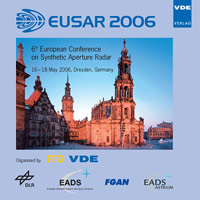Analysis and Focusing of Bistatic Airborne SAR Data
Konferenz: EUSAR 2006 - 6th European Conference on Synthetic Aperture Radar
16.05.2006 - 18.05.2006 in Dresden, Germany
Tagungsband: EUSAR 2006
Seiten: 4Sprache: EnglischTyp: PDF
Persönliche VDE-Mitglieder erhalten auf diesen Artikel 10% Rabatt
Autoren:
Nies, Holger; Loffeld, Otmar; Natroshvili, Koba (Center for Sensorsystems (ZESS), University of Siegen, Germany)
Inhalt:
Bistatic SAR processing requires precise knowledge about geometrical parameters of the flown bistatic constellation, whereas the estimation of these parameters is even more important than in the monostatic case. As it is not possible to separate the individual semi monostatic parameters from the bistatic dataset, the searched parameters are derived from the tracks of the moving platforms. For this reason Global Positioning System (GPS) and Inertial Navigation System (INS) data of transmitter and receiver are combined in an optimal way by a Kalman filter approach. As a consequence of model based interpolation we can easily determine parameters like Doppler centroid frequency, velocity and the bistatic parameters a2 and a0 referring to the illuminated scene at each time instant. The precisely determined position and velocity information of transmitter and receiver enables an accurate bistatic motion compensation, which is also described in this paper. For verifying our approach GPS/INS tracks and raw data of a bistatic airborne SAR experiment flown in 2003 were used, where the data was kindly provided by FGAN1. The focusing was done by a Scaled Inverse Fourier Transformation (SIFT) processor. The error analysis was performed by generating simulated raw data for ideal point targets on the ground, based on the trajectories of the two platforms. After focusing this raw data using our processing approach, we can see any deformation of the point targets in comparison to a correctly focused point target and compare this result with the result obtained from real raw data.


